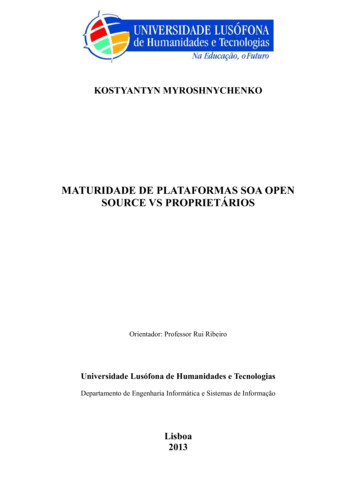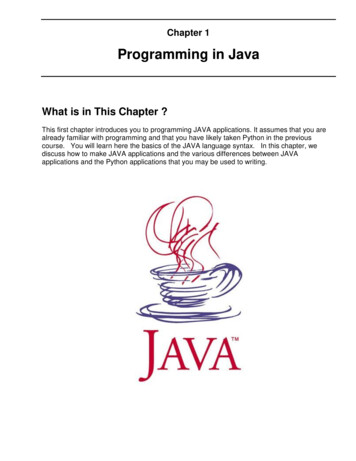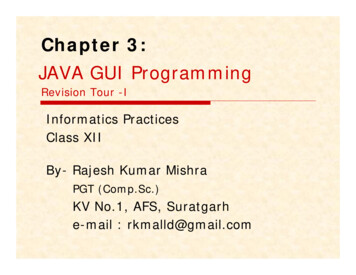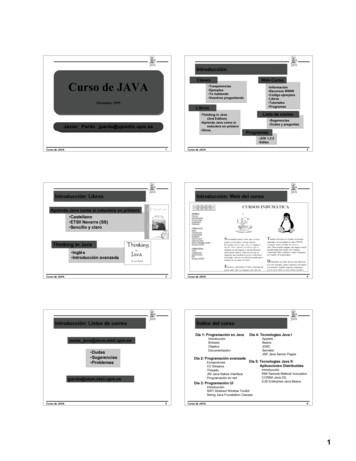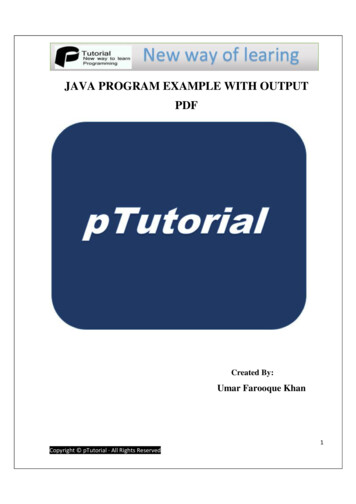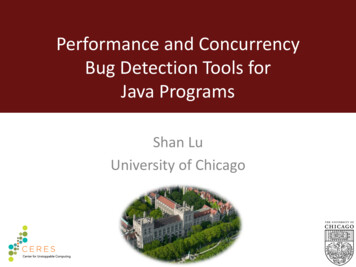
Transcription
www.allitebooks.com
Java PerformanceCompanion www.allitebooks.com
This page intentionally left blankwww.allitebooks.com
Java PerformanceCompanion Charlie HuntMonica BeckwithPoonam ParharBengt RutissonBoston Columbus Indianapolis New York San Francisco Amsterdam Cape TownDubai London Madrid Milan Munich Paris Montreal Toronto Delhi Mexico CitySão Paulo Sidney Hong Kong Seoul Singapore Taipei Tokyowww.allitebooks.com
Many of the designations used by manufacturers and sellers to distinguish their products are claimed astrademarks. Where those designations appear in this book, and the publisher was aware of a trademark claim,the designations have been printed with initial capital letters or in all capitals.The authors and publisher have taken care in the preparation of this book, but make no expressed orimplied warranty of any kind and assume no responsibility for errors or omissions. No liability is assumedfor incidental or consequential damages in connection with or arising out of the use of the information orprograms contained herein.For information about buying this title in bulk quantities, or for special sales opportunities (which may includeelectronic versions; custom cover designs; and content particular to your business, training goals, marketingfocus, or branding interests), please contact our corporate sales department at corpsales@pearsoned.com or(800) 382-3419.For government sales inquiries, please contact governmentsales@pearsoned.com.For questions about sales outside the United States, please contact intlcs@pearson.com.Visit us on the Web: informit.com/awCataloging-in-Publication Data is on file with the Library of Congress.Copyright 2016 Pearson Education, Inc.All rights reserved. Printed in the United States of America. This publication is protected by copyright, andpermission must be obtained from the publisher prior to any prohibited reproduction, storage in a retrievalsystem, or transmission in any form or by any means, electronic, mechanical, photocopying, recording, orlikewise. For information regarding permissions, request forms and the appropriate contacts within thePearson Education Global Rights & Permissions Department, please visit www.pearsoned.com/permissions.ISBN-13: 978-0-13-379682-7ISBN-10: 0-13-379682-5Text printed in the United States on recycled paper at RR Donnelley in Crawfordsville, Indiana.First printing, April 2016www.allitebooks.com
ContentsPrefaceixAcknowledgmentsxiAbout the AuthorsxvChapter 1Garbage First Overview1Terminology1Parallel GC2Serial GC4Concurrent Mark Sweep (CMS) GC5Summary of the CollectorsGarbage First (G1) GC78G1 Design10Humongous Objects12Full Garbage Collections12Concurrent Cycle13Heap Sizing14References14vwww.allitebooks.com
viChapter 2ContentsGarbage First Garbage Collector in Depth15Background15Garbage Collection in G116The Young Generation17A Young Collection Pause18Object Aging and the Old Generation19Humongous Regions19A Mixed Collection Pause22Collection Sets and Their Importance24Remembered Sets and Their Importance24Concurrent Refinement Threads and BarriersChapter 328Concurrent Marking in G1 GC30Stages of Concurrent Marking34Initial Mark34Root Region Scanning34Concurrent Marking34Remark36Cleanup36Evacuation Failures and Full Collection37References38Garbage First Garbage Collector Performance Tuning39The Stages of a Young Collection39Start of All Parallel Activities41External Root Regions42Remembered Sets and Processed Buffers42Summarizing Remembered Sets44Evacuation and Reclamation47Termination47Parallel Activity Outside of GC48Summarizing All Parallel Activities48Start of All Serial Activities48Other Serial Activities49Young Generation Tunables50www.allitebooks.com
viiContentsChapter 4Concurrent Marking Phase Tunables52A Refresher on the Mixed Garbage Collection Phase54The Taming of a Mixed Garbage Collection Phase56Avoiding Evacuation Failures59Reference Processing60Observing Reference Processing60Reference Processing Tuning62References65The Serviceability Agent67What Is the Serviceability Agent?68Why Do We Need the SA?68SA Components69SA Binaries in the JDK69JDK Versions with Complete SA Binaries69How the SA Understands HotSpot VM Data Structures70SA Version Matching71The Serviceability Agent Debugging Tools72HSDB72HSDB Tools80CLHSDB100Some Other Tools103Core Dump or Crash Dump Files108Debugging Transported Core Files109Shared Library Problems with the SA109Eliminate Shared Library Problems110System Properties for the Serviceability Agent111Environment Variables for the Serviceability Agent112JDI Implementation113Extending Serviceability Agent Tools115Serviceability Agent Plugin for VisualVM117How to Install the SA-Plugin in VisualVM118How to Use the SA-Plugin118SA-Plugin Utilities119www.allitebooks.com
viiiContentsTroubleshooting Problems Using the SAAppendix123Diagnosing OutOfMemoryError123Diagnosing a Java-Level Deadlock131Postmortem Analysis of a HotSpot VM Crash136Additional HotSpot VM Command-Line Options of InterestIndex145155www.allitebooks.com
PrefaceWelcome to the Java Performance Companion. This book offers companion materialto Java Performance [1], which was first published in September 2011. Althoughthe additional topics covered in this book are not as broad as the material in Java Performance, they go into enormous detail. The topics covered in this book are the G1garbage collector, also known as the Garbage First garbage collector, and the JavaHotSpot VM Serviceability Agent. There is also an appendix that covers additionalHotSpot VM command-line options of interest that were not included in the Java Performance appendix on HotSpot VM command-line options.If you are currently using Java 8, have interest in migrating to Java 8, or haveplans for using Java 9, you will likely be either evaluating G1 GC or already usingit. Hence, the information in this book will be useful to you. If you have interest indiagnosing unexpected HotSpot VM failures, or in learning more about the details ofa modern Java Virtual Machine, this book’s content on the HotSpot VM ServiceabilityAgent should be of value to you, too. The HotSpot VM Serviceability Agent is the toolof choice for not only HotSpot VM developers but also the Oracle support engineerswhose daily job involves diagnosing and troubleshooting unexpected HotSpot VMbehavior.This book begins with an overview of the G1 garbage collector by offering somecontext around why G1 was implemented and included in HotSpot VM as a GC. It thengoes on to offer an overview of how the G1 garbage collector works. This chapter isfollowed by two additional chapters on G1. The first is an in-depth description of theinternals of G1. If you already have a good understanding of how the G1 garbageixwww.allitebooks.com
xPrefacecollector works, and either have a need to further fine-tune G1 or want to know moreabout its inner workings, this chapter would be a great place to start. The third chapter on G1 is all about fine-tuning G1 for your application. One of the main designpoints for G1 was to simplify the tuning required to realize good performance. Forinstance, the major inputs into G1 are the initial and maximum Java heap size it canuse, and a maximum GC pause time you are willing to tolerate. From there G1 willattempt to adaptively adjust to meet those inputs while it executes your application.In circumstances where you would like to achieve better performance, or you wouldlike to do some additional tuning on G1, this chapter has the information you arelooking for.The remaining chapter is dedicated entirely to the HotSpot VM ServiceabilityAgent. This chapter provides an in-depth description of and instructions for how touse the Serviceability Agent. If you have interest in learning more about the internals of the HotSpot VM, or how to troubleshoot and diagnose unexpected HotSpotVM issues, this is a good chapter for you. In this chapter you will learn how to usethe HotSpot VM Serviceability Agent to observe and analyze HotSpot VM behaviorin a variety of ways through examples and illustrations.Last, there is an appendix that includes HotSpot VM command-line options thatwere not included in Java Performance’s appendix on HotSpot VM command-lineoptions. Many of the HotSpot VM command-line options found in the appendix arerelated to G1. And, rather than merely listing these options with only a description,an attempt is made to also mention when it is appropriate to use them.References[1] Charlie Hunt and Binu John. JavaTM Performance. Addison-Wesley, Upper SaddleRiver, NJ, 2012. ISBN 978-0-13-714252-1.Register your copy of Java Performance Companion at informit.com forconvenient access to downloads, updates, and corrections as they becomeavailable. To start the registration process, go to informit.com/register and login or create an account. Enter the product ISBN (9780133796827) and clickSubmit. Once the process is complete, you will find any available bonus contentunder “Registered Products.”
AcknowledgmentsCharlie HuntFor those who have ever considered writing a book, or are curious about the effortinvolved in doing so, the book-writing experience is a major undertaking! For me itjust would not have happened without the help of so many people. I cannot begin tomention everyone who made this possible.In an attempt to at least name those who have had a profound impact on this bookgetting drafted and eventually into print, I would first like to thank my coauthors,Monica Beckwith, Bengt Rutisson, and Poonam Parhar. When the idea of doing acompanion book to Java Performance first surfaced, I thought it would be greatto offer the opportunity to these talented HotSpot VM engineers to showcase theirexpertise. I am sure I have learned much more from each of them than they havelearned from me. I could not be prouder of their contributions to this book.I also extend sincere thanks to Monica Beckwith for her persistence and passionin sharing her in-depth knowledge of G1 GC. In the early days of G1, I had the pleasure of working with Monica on a daily basis on G1 performance, eventually handingoff full reins to her. She has done an exceptional job with driving G1’s performanceand sharing her G1 knowledge.I also have to explicitly call out Poonam Parhar and thank her for her patience.Poonam so patiently waited for the other contributors to complete their initialdrafts—patiently as in years of patience! Had all of us finished our drafts in a timelyway, this book probably would have been on the shelf at least two years earlier.xi
xiiAcknowledgmentsI also extend my thanks to the entire HotSpot VM team, the HotSpot GCengineering team, and in particular the G1 GC engineers, both past and present.And to the reviewers of the material in this book: Paul Hohensee for his relentlessattention to detail and incredible suggestions for improved readability, and TonyPrintezis for his thorough review of the gory details of G1 GC and recommendedtuning of G1.Thanks also to John Cuthbertson for sharing his knowledge of G1. John alsohappens to be one of the most talented concurrency troubleshooting engineers I haveever worked with. I don’t think I ever saw a situation where I was able to stump himwith some bizarre observation about G1 that was clearly some kind of concurrencybug. He was always able to track it down.And to Bernard Traversat and Georges Saab for their support and encouragementin pulling together material for a follow-on to Java Performance.And obviously thanks to Greg Doench, our editor, for his patience with our manydelays in delivering drafts, completing reviews, and getting the manuscript in shapeto put in his hands.Last, thanks to my wife, Barb, and son, Boyd, for putting up with yet another round ofthe book-writing experience!Monica BeckwithI felt honored when I was approached by my mentor Charlie Hunt to write a fewchapters for this book. I didn’t have the slightest idea that it would take me solong. So, my first set of thanks goes to my fellow writers for their patience and toCharlie for his persistence and encouragement throughout. While we are talkingabout encouragement, I want to thank my hubby, Ben Beckwith—when he saw myfrustration he had nothing but words of encouragement for me. He was also theinitial reviewer of my drafts. Thank you, Ben. And then, of course, my two kiddos,Annika and Bodin, and my mom, Usha, who have been nothing but supportive of meand of this book.My technical strength on G1 taps off John Cuthbertson, and I am thankful tohim for supporting my crazy queries and patiently listening and working withme to “make G1 adaptive” and to “tame mixed collections.” When we used todiscuss the adaptive marking threshold, I got tired of typing and talking aboutInitiatingHeapOccupancyPercent, so I shortened it to IHOP and John just lovedit. It’s really hard to find such supportive colleagues as John and Charlie.And then there are Paul Hohensee and Tony Printezis. They are my mentors intheir own right, and I can assure you that their persistence in reviewing my chaptershas improved the readability and content by at least 75 percent! :)Thank you all for trusting me and encouraging me. I am forever in your debt!
AcknowledgmentsxiiiPoonam ParharI was deeply honored and excited when Charlie suggested that I write a chapter on theServiceability Agent. I thought it was a great idea, as this wonderful tool is little knownto the world, and it would be great to talk about its usefulness and capabilities. But I hadnever written a book before, and I was nervous. Big thanks to Charlie for his trust in me,for his encouragement, and for guiding me throughout writing the chapter on the SA.I would like to thank my manager, Mattis Castegren, for always being supportiveand encouraging of my work on this book, and for being the first reviewer of thechapter on the SA. Huge thanks to Kevin Walls for reviewing my chapter and helpingme improve the quality of the content.Special thanks to my husband, Onkar, who is my best friend, too, for being supportive and always being there whenever I need help. And of course I am gratefulto my two little angels, Amanvir and Karanvir, who are my continuous source ofmotivation and happiness.And my most sincere thanks to my father, Subhash C. Bajaj, for his infectiouscheerfulness and for being a source of light, and for always inspiring me to nevergive up.Bengt RutissonWhen Charlie asked me to write a chapter for this book, I was very honored andflattered. I had never written a book before and clearly had no idea how muchwork it is—even to write just one chapter! I am very grateful for all the supportfrom Charlie and the reviewers. Without their help, I would not have been able tocomplete this chapter.A big thanks to my wife, Sara Fritzell, who encouraged me throughout the workand helped me set up deadlines to get the chapter completed. And, of course, manythanks to our children, Max, Elsa, Teo, Emil, and Lina, for putting up with me duringthe writing period.I would also like to thank all of the members of the HotSpot GC engineeringteam, both past and present. They are by far the most talented bunch of engineersI have ever worked with. I have learned so much from all of them, and they have allinspired me in so many ways.
This page intentionally left blank
About the AuthorsCharlie Hunt (Chicago, IL) is currently a JVM Engineer at Oracle leading a varietyof Java SE and HotSpot VM projects whose primary focus is reducing memoryfootprint while maintaining throughput and latency. He is also the lead author ofJava Performance (Addison-Wesley, 2012). He is a regular presenter at the JavaOneConference where he has been recognized as a Java Rock Star. He has also beena speaker at other well-known conferences, including QCon, Velocity, GoTo, andDreamforce. Prior to leading a variety of Java SE and HotSpot VM projects for Oracle,Charlie worked in several different performance positions, including PerformanceEngineering Architect at Salesforce.com and HotSpot VM Performance Architect atOracle and Sun Microsystems. He wrote his first Java application in 1998, joinedSun Microsystems in 1999 as Senior Java Architect, and has had a passion for Javaand JVM performance ever since.Monica Beckwith is an Independent Performance Consultant optimizing customerapplications for server-class systems running the Java Virtual Machine. Her pastexperiences include working with Oracle, Sun Microsystems, and AMD. Monica hasworked with Java HotSpot VM optimizing the JIT compiler, the generated code, theJVM heuristics, and garbage collection and collectors. She is a regular speaker atvarious conferences and has several published articles on topics including garbagecollection, the Java memory model, and others. Monica led Oracle’s Garbage FirstGarbage Collector performance team, and was named a JavaOne Rock Star.xv
xviAbout the AuthorsPoonam Parhar (Santa Clara, CA) is currently a JVM Sustaining Engineer at Oraclewhere her primary responsibility is to resolve customer-escalated problems againstJRockit and HotSpot VMs. She loves debugging and troubleshooting problems andis always focused on improving the serviceability and supportability of the HotSpotVM. She has nailed down many complex garbage collection issues in the HotSpot VMand is passionate about improving the debugging tools and the serviceability of theproduct so as to make it easier to troubleshoot and fix garbage-collector-related issuesin the HotSpotVM. She has made several contributions to the Serviceability Agentdebugger and also developed a VisualVM plugin for it. She presented “VisualVMPlugin for the SA” at the JavaOne 2011 conference. In an attempt to help customersand the Java community, she shares her work experiences and knowledge throughthe blog she maintains at https://blogs.oracle.com/poonam/.Bengt Rutisson (Stockholm, Sweden) is a JVM Engineer at Oracle, working on theHotSpot engineering team. He has worked on garbage collectors in JVMs for thepast 10 years, first with the JRockit VM and the last six years with the HotSpot VM.Bengt is an active participant in the OpenJDK project, with many contributions offeatures, stability fixes, and performance enhancements.
1Garbage FirstOverviewThis chapter is an introduction to the Garbage First (or G1) garbage collector (GC)along with a historical perspective on the garbage collectors in the Java HotSpotVirtual Machine (VM), hereafter called just HotSpot, and the reasoning behindG1’s inclusion in HotSpot. The reader is assumed to be familiar with basic garbagecollection concepts such as young generation, old generation, and compaction.Chapter 3, “JVM Overview,” of the book Java Performance [1] is a good source forlearning more about these concepts.Serial GC was the first garbage collector introduced in HotSpot in 1999 as partof Java Development Kit (JDK) 1.3.1. The Parallel and Concurrent Mark Sweepcollectors were introduced in 2002 as part of JDK 1.4.2. These three collectors roughlycorrespond to the three most important GC use cases: “minimize memory footprintand concurrent overhead,” “maximize application throughput,” and “minimizeGC-related pause times.” One might ask, “Why do we need a new collector such asG1?” Before answering, let’s clarify some terminology that is often used when comparingand contrasting garbage collectors. We’ll then move on to a brief overview of the fourHotSpot garbage collectors, including G1, and identify how G1 differs from the others.TerminologyIn this section, we define the terms parallel, stop-the-world, and concurrent. The termparallel means a multithreaded garbage collection operation. When a GC event activityis described as parallel, multiple threads are used to perform it. When a garbage1
2Chapter 1Garbage First Overviewcollector is described as parallel, it uses multiple threads to perform garbage collection.In the case of the HotSpot garbage collectors, almost all multithreaded GC operationsare handled by internal Java VM (JVM) threads. One major exception to this is theG1 garbage collector, in which some background GC work can be taken on by theapplication threads. For more detail see Chapter 2, “Garbage First Garbage Collectorin Depth,” and Chapter 3, “Garbage First Garbage Collector Performance Tuning.”The term stop-the-world means that all Java application threads are stoppedduring a GC event. A stop-the-world garbage collector is one that stops all Javaapplication threads when it performs a garbage collection. A GC phase or event maybe described as stop-the-world, which means that during that particular GC phaseor event all Java application threads are stopped.The term concurrent means that garbage collection activity is occurring at thesame time as the Java application is executing. A concurrent GC phase or eventmeans that the GC phase or event executes at the same time as the application.A garbage collector may be described by any one or a combination of these threeterms. For example, a parallel concurrent collector is multithreaded (the parallelpart) and also executes at the same time as the application (the concurrent part).Parallel GCParallel GC is a parallel stop-the-world collector, which means that when a GC occurs, itstops all application threads and performs the GC work using multiple threads. The GCwork can thus be done very efficiently without any interruptions. This is normally thebest way to minimize the total time spent doing GC work relative to application work.However, individual pauses of the Java application induced by GC can be fairly long.Both the young and old generation collections in Parallel GC are parallel andstop-the-world. Old generation collections also perform compaction. Compactionmoves objects closer together to eliminate wasted space between them, leading to anoptimal heap layout. However, compaction may take a considerable amount of time,which is generally a function of the size of the Java heap and the number and sizeof live objects in the old generation.At the time when Parallel GC was introduced in HotSpot, only the younggeneration used a parallel stop-the-world collector. Old generation collections used asingle-threaded stop-the-world collector. Back when Parallel GC was first introduced,the HotSpot command-line option that enabled Parallel GC in this configuration was-XX: UseParallelGC.At the time when Parallel GC was introduced, the most common use case forservers required throughput optimization, and hence Parallel GC became thedefault collector for the HotSpot Server VM. Additionally, the sizes of most Javaheaps tended to be between 512MB and 2GB, which keeps Parallel GC pause times
Parallel GC3relatively low, even for single-threaded stop-the-world collections. Also at the time,latency requirements tended to be more relaxed than they are today. It was commonfor Web applications to tolerate GC-induced latencies in excess of one second, and asmuch as three to five seconds.As Java heap sizes and the number and size of live objects in old generation grew,the time to collect the old generation became longer and longer. At the same time,hardware advances made more hardware threads available. As a result, Parallel GCwas enhanced by adding a multithreaded old generation collector to be used with amultithreaded young generation collector. This enhanced Parallel GC reduced thetime required to collect and compact the heap.The enhanced Parallel GC was delivered in a Java 6 update release. It wasenabled by a new command-line option called -XX: UseParallelOldGC. When-XX: UseParallelOldGC is enabled, parallel young generation collection is alsoenabled. This is what we think of today as Parallel GC in HotSpot, a multithreadedstop-the-world young generation collector combined with a multithreaded stop-theworld old generation collector.TipIn Java 7 update release 4 (also referred to as Java 7u4, or JDK 7u4), - XX: UseParallelOldGCwas made the default GC and the normal mode of operation for Parallel GC. As of Java 7u4,specifying -XX: UseParallelGC also enables -XX: UseParallelOldGC, and likewisespecifying -XX: UseParallelOldGC also enables -XX: UseParallelGC.Parallel GC is a good choice in the following use cases:1. Application throughput requirements are much more important than latencyrequirements.A batch processing application is a good example since it is noninteractive. Whenyou start a batch execution, you expect it to run to completion as fast as possible.2. If worst-case application latency requirements can be met, Parallel GC will offerthe best throughput. Worst-case latency requirements include both worst-casepause times, and also how frequently the pauses occur. For example, an applicationmay have a latency requirement of “pauses that exceed 500ms shall not occurmore than once every two hours, and all pauses shall not exceed three seconds.”An interactive application with a sufficiently small live data size such thata Parallel GC’s full GC event is able to meet or beat worst-case GC-inducedlatency requirements for the application is a good example that fits this use case.However, since the amount of live data tends to be highly correlated with the sizeof the Java heap, the types of applications falling into this category are limited.
4Chapter 1GCThreadsGarbage First OverviewAppThreadsFigure 1.1 How Java application threads are interrupted by GC threadswhen Parallel GC is usedParallel GC works well for applications that meet these requirements. Forapplications that do not meet these requirements, pause times can become excessivelylong, since a full GC must mark through the entire Java heap and also compact theold generation space. As a result, pause times tend to increase with increased Javaheap sizes.Figure 1.1 illustrates how the Java application threads (gray arrows) are stoppedand the GC threads (black arrows) take over to do the garbage collection work. Inthis diagram there are eight parallel GC threads and eight Java application threads,although in most applications the number of application threads usually exceeds thenumber of GC threads, especially in cases where some application threads may beidle. When a GC occurs, all application threads are stopped, and multiple GC threadsexecute during GC.Serial GCSerial GC is very similar to Parallel GC except that it does all its work in a singlethread. The single-threaded approach allows for a less complex GC implementationand requires very few external runtime data structures. The memory footprint is thelowest of all HotSpot collectors. The challenges with Serial GC are similar to thosefor Parallel GC. Pause times can be long, and they grow more or less linearly withthe heap size and amount of live data. In addition, with Serial GC the long pausesare more pronounced, since the GC work is done in a single thread.
5Concurrent Mark Sweep (CMS) GCGCThreadAppThreadsFigure 1.2 How Java application threads are interrupted by a single GC thread whenSerial GC is usedBecause of the low memory footprint, Serial GC is the default on the Java HotSpotClient VM. It also addresses the requirements for many embedded use cases. SerialGC can be explicitly specified as the GC to use with the -XX: UseSerialGC HotSpotcommand-line option.Figure 1.2 illustrates how Java application threads (gray arrows) are stoppedand a single GC thread (black arrow) takes over to do the garbage collection workon a machine running eight Java application threads. Because it is single-threaded,Serial GC in most cases will take longer to execute a GC event than Parallel GC sinceParallel GC can spread out the GC work to multiple threads.Concurrent Mark Sweep (CMS) GCCMS GC was developed in response to an increasing number of applications thatdemand a GC with lower worst-case pause times than Serial or Parallel GC andwhere it is acceptable to sacrifice some application throughput to eliminate or greatlyreduce the number of lengthy GC pauses.In CMS GC, young garbage collections are similar to those of Parallel GC. They areparallel stop-the-world, meaning all Java application threads are paused during younggarbage collections and the garbage collection work is performed by multiple threads.Note that you can configure CMS GC with a single-threaded young generation collector, but this option has been deprecated in Java 8 and is removed in Java 9.The major difference between Parallel GC and CMS GC is the old generationcollection. For CMS GC, the old generation collections attempt to avoid long pauses in
6Chapter 1Garbage First Overviewapplication threads. To achieve this, the CMS old generation collector does most of itswork concurrently with application thread execution, except for a few relatively shortGC synchronization pauses. CMS is often referred to as mostly concurrent, since thereare some phases of old generation collection that pause application threads. Examples are the initial-mark and remark phases. In CMS’s initial implementation, boththe initial-mark and remark phases were single-threaded, but they have since beenenhanced to be multithreaded. The HotSpot command-line options to support multithreaded initial-mark and remark phases are -XX: CMSParallelInitialMarkEnabled and -XX:CMSParallelRemarkEnabled. These are automaticallyenabled by default when CMS GC is enabled by the -XX: UseConcurrentMarkSweepGC command-line option.It is possible, and quite likely, for a young generation collection to occur whilean old generation concurrent collection is taking place. When this happens, the oldgeneration concurrent collection is interrupted by the young generation collectionand immediately resumes upon the latter’s completion. The default young generationcollector for CMS GC is commonly referred to as ParNew.Figure 1.3 shows how Java application threads (gray arrows) are stopped for theyoung GCs (black arrows) and for the CMS initial-mark and remark phases, and oldgeneration GC stop-the-world p
Welcome to the Java Performance Companion. This book offers companion material to Java Performance [1], which was first published in September 2011. Although the additional topics covered in this book are not as broad as the material in Java Performance, they go into enormous detail. The topics covered in this book are the G1


